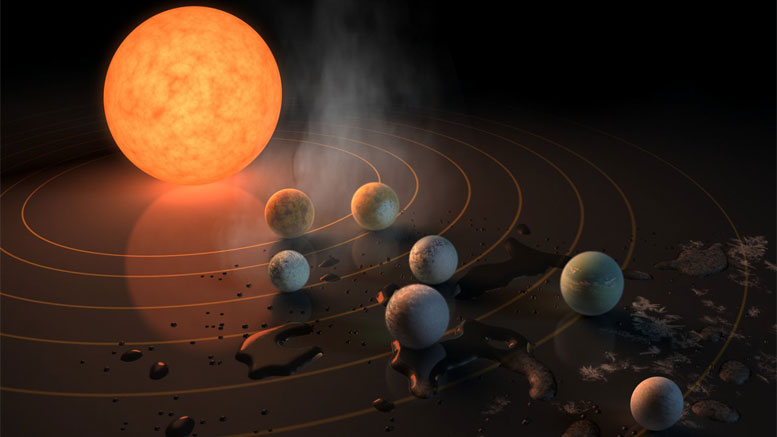
Astronomers from the University of Amsterdam declare a model how it is that seven planets in character format running close to their star around the solar Trappist-1 (an artistic impression here). The crux lies on the border where ice turns into water. (c) NASA / R. Hurt / T. Pyle
(Article translated to English)
Astronomers from the University of Amsterdam have developed a model to explain the formation of planetary system Trappist-1 and other compact systems.
The first seven planets in the Trappist-1 system are the size of Earth and orbit very close to their star. According to the new research, the crux lies on the border where ice turns into water. Near that ice line, pebbles that drifted from outer regions to the star receive an additional portion of water and clot together to form proto-planets. The research has been accepted for publication in the journal Astronomy & Astrophysics.
In February 2017, an international team of astronomers announced that they had discovered a system of seven planets the size of Earth that orbit close to their star. It was against the prevailing theories of planet formation that so many relatively large planets could orbit so close around a small star. Now astronomers at the University of Amsterdam present a model that explains how the planetary system could have originated.
Until now there were two prevailing theories for the formation of planets. The first theory assumes that planets form where you see them. With Trappist-1, that is unlikely because the disk from which the planets had originated should have been very dense. The second theory assumes that a planet forms on the outside of the fabric disk, and then migrates to the inside. This theory also presents problems in Trappist-1 because it does not explain why the planets are about the same size as Earth.
Now, the Amsterdam researchers have developed a model where grit and pebbles migrate instead of entire planets. The model starts with pebbles consisting of ice that are floating in outside regions that are pulled toward the star. When the pebbles arrive near the so-called ice line, the point where it is warm enough for liquid water, they get an additional portion of water vapor to process. As a result, they clot together into a proto-planet. Then the proto-planet moves a little closer to the star. On its way toward the star it sweeps up more pebbles, like a vacuum cleaner, until it reaches the size of the Earth. The planet then moves in a little further and makes room for the formation of the next planet.
The crux, according to the researchers, is in the clotting of pebbles near the ice line. By crossing the ice line, pebbles lose their water ice. But that water is re-used by the following load of pebbles that is drifting from the outer regions of the dust disk. At Trappist-1, this process repeated until seven planets were formed.
“For us, Trappist-1 with its seven planets came as a welcome surprise. We have been working on pebble aggregation by planets for a long time and developing a new ice-line model. Thanks to the discovery of Trappist-1 we can compare our model with reality.”
In the near future, the Amsterdam astronomers want to refine their model. They will run computer simulations to see how their model withstands different initial conditions. The astronomers still expect some discussion among fellow researchers. The model is quite revolutionary because the pebbles travel from the outer part of the disk to the ice line without much activity in between.
“I hope that our model will help answer the question about how unique our own solar system is compared to other planetary systems.”
Reference: Formation of Trappist-1 and other compact systems” by Chris W. Ormel, Beibei Liu (刘倍贝) and Djoeke Schoonenberg, 28 July 2017, Astronomy & Astrophysics.
DOI: 10.1051/0004-6361/201730826
Abstract: TRAPPIST-1 is a nearby 0.08 M M-star, which was recently found to harbor a planetary system of at least seven Earth-mass planets, all within 0.1 au. The configuration confounds theorists as the planets are not easily explained by either in situ or migration models. In this Paper we present a scenario for the formation and orbital architecture of the TRAPPIST-1 system. In our model, planet formation starts at the H2O iceline, where pebble-size particles — whose origin is the outer disk — concentrate to trigger streaming instabilities. After their formation, planetary embryos quickly mature by pebble accretion. Planet growth stalls at Earth masses, where the planet’s gravitational feedback on the disk keeps pebbles at bay. Planets are transported by Type I migration to the inner disk, where they stall at the magnetospheric cavity and end up in mean motion resonances. During disk dispersal, the cavity radius expands and the inner-most planets escape resonance. We argue that the model outlined here can also be applied to other compact systems and that the many close-in super-Earth systems are a scaled-up version of TRAPPIST-1. We also hypothesize that few close-in compact systems harbor giant planets at large distances, since they would have stopped the pebble flux from the outer disk.

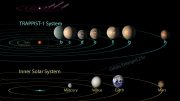
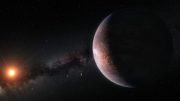
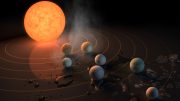



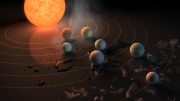
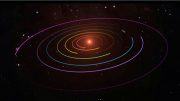
Be the first to comment on "Researchers Explain the Formation of Trappist-1 and Other Compact Systems"